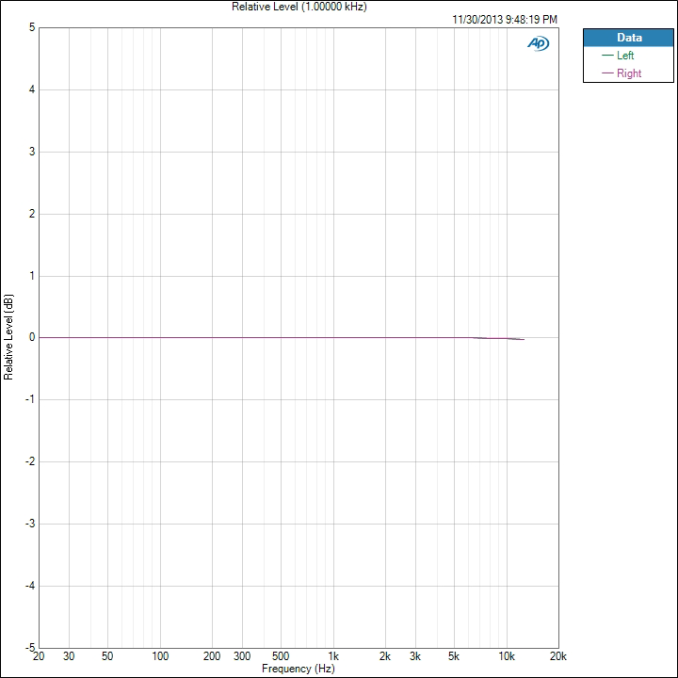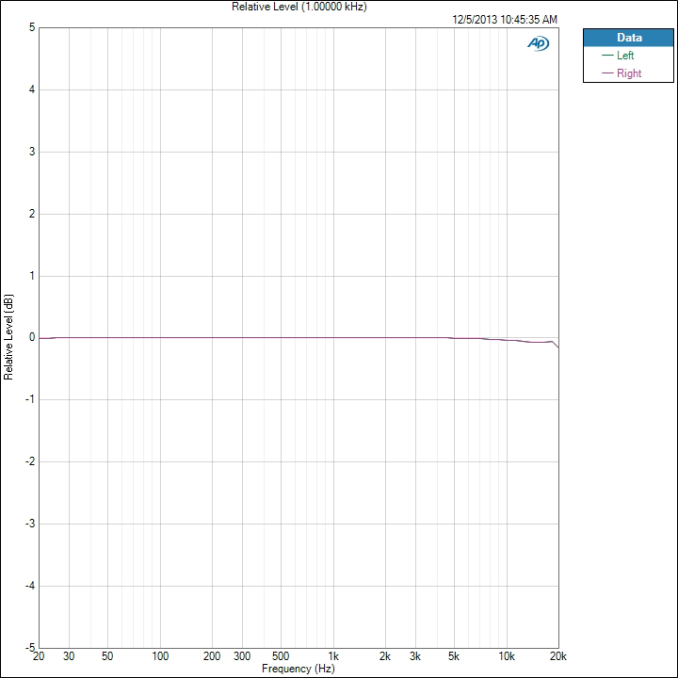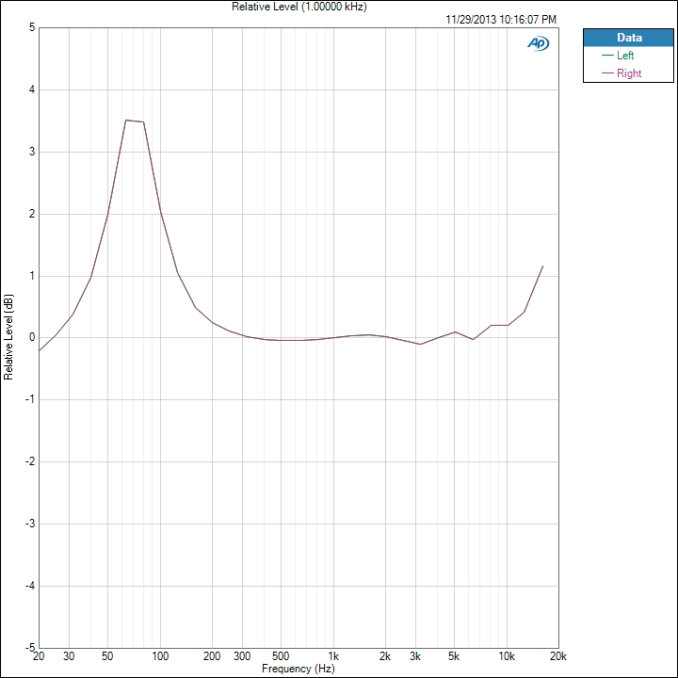Smartphone Audio Quality Testing
by Chris Heinonen on December 8, 2013 5:15 PM EST- Posted in
- Smartphones
- Audio
- Mobile
- Tablets
- Testing
Maximum Level
The maximum output level is derived from the 1kHz test tone used to determine THD+N. The higher the output from the headphone jack, the louder it can drive a pair of headphones. More importantly, having more power available means when you have dynamic music passages that call for power you are less likely to clip the waveform.
There is no chart to show here, just a number that the Audio Precision gives us. In our test data, the most powerful phone was the iPhone 5, at 32.46 mW of power. Next is the Nexus 5 at 22.24 mW, though we can’t drive it that high. Then the Note 3 at 11.81 mW and finally the Galaxy S4 at 3.895 mW. Doubling the power, from 4 mW to 8 mW, produces a 3 dB increase in volume level. 3 dB is the smallest change in volume levels we can easily hear. So even though the iPhone 5 produces 32 mW vs. 4 mW, that is only a 9 dB difference in volume. 10 dB is doubling the volume, so it isn’t even twice as loud. If you have demanding headphones, you will want as much power as you can get.
Frequency Response
To measure the frequency response we measure a set of 61 tones from 20 Hz to 20 kHz. All of these are then equalized to 1 kHz so we can see the maximum deviation from that level. An ideal phone will be perfectly flat here and allow you to adjust this with an EQ setting, or though your taste in headphones. On this test our best performing phone is the Galaxy S4, as seen here.
The total variation from 1 kHz is only 0.014 dB which is very good. The worst performing phone is the iPhone 5, but its variation is only 0.089 dB.
The iPhone 5 also picked up the 20 kHz tone while the Samsung and many others missed it. If we dropped this tone then it might be just as flat. The iPhone 5 test was run slightly differently, as it can't run the Android test program, which might account for this. For a phone with a different response, here is the HTC One with Beats enabled. Other HTC One testing is still in progress as I write this article.
Here we see that Beats is adding a +3.5 dB boost from 60 Hz to 90 Hz, but the deviation from 0 dB goes from 30Hz to 300 Hz. Past 6.5 kHz we also see a rise in the treble. People often mistake boosted treble for extra detail, which is likely the reasoning behind this. As we see it is far different than the other two examples we looked at.













188 Comments
View All Comments
UsernameAlreadyExists - Friday, December 13, 2013 - link
That would be great. I believe most display tests are run with the same light output to have more reasonable comparisons... I would like to see the same principle here. As a curiosity (or a warning) it would be good to know that above certain levels the sound will deteriorate.bob11d50 - Sunday, December 8, 2013 - link
I would love to see the distortion of the apple on a standard headphone (16 ohms). They have notoriously bad sound quality all they way back to the first ipod. Apple is a profit company not a quality company.I would also like to see a real comparison of battery life on apple products. Like battery life VS screen size in SQ inches. The screen is so small who cares if it can brows the web for 10 hours if you cant see it.
Also frame rate VS pixel count. Once again I can refresh a 1 pixel screen at 1Mhz but it does not do me any good nor does a 1M Pixel screen at 1 Hz but the spec is the same 1M pixels a second.
Robert
NeoteriX - Monday, December 9, 2013 - link
I am not an Apple evangelist having only owned Android (and WM and Palm) smartphone devices. So with that said, this is a truly ignorant statement. Apple has led the way on several different design and hardware fronts, including display quality and size, camera quality, GPU power, etc., and it's not clear that without their leadership there would be the kind of robust hardware competition there is in the PC and Android space.deasys - Monday, December 9, 2013 - link
"They have notoriously bad sound quality all they way back to the first iPod"Sure, Bob, whatever you say. Of course, there are authoritative sources that disagree with you. For example: http://www.stereophile.com/content/apple-ipod-port... which summarizes by stating, "Excellent, cost-effective audio engineering from an unexpected source."
I think I'll take Stereophile's word over yours, Bob…
akdj - Monday, December 9, 2013 - link
deasys hit the nail on the head Bob---Not sure which iPod/iOS device YOU'VE hear/listened to/had experience with....but as an absolute audio nerd, I can assure you decent audio files sound excellent....my favorite cans right now are the B&W P5s currently, but I've also got 2 pairs of Grados, Sony MDR 7520s, and Sennheiser HD800s for our studio mixing (with B&W Nautilus 802 speakers and Focal SM9 studio monitors). You couldn't be more dead wrong about Apple's sound quality. Perhaps you need to find a new way to 'rip' your music or quit listening to low bitrate MP3s to judge sound quality?As far as screen/battery life----WTF does that have to do with this incredibly extensive, exhaustive sound quality review and comparison/contrast between three Android phones and an iPhone?
Bone to pick, eh?
LoL----Doesn't matter does it....regardless of the article, review, discussion----always SOMETHING to do with Apple isn't it?
winchuff - Wednesday, December 18, 2013 - link
The devil is always in the detail... Unfortunately deasy, the detail you failed to pick up on is that the 'stereophile' tests were performed into the mackintosh powerbook 'line in' impedance and so did not uncover the limitations of the analogue output stage when listening via headphones.winchuff - Wednesday, December 18, 2013 - link
You're dead right Bob (whatever the other numpties say). The problem with the ipods (except for the first gen iPod nano, which was superb) is down to an underpowered analogue output stage. There is no problem when driving a high impedance 'line out', but it results in clipping and poor bass response when driving (low impedance) headphones. For those of us listening via headphones, the most crucial objective test is performed when driving into a low impedance. If anandtech do the low impedance tests, you will be vindicated for identifying the shortcomings of the apple devices. And the numpties who know no better will eat humble pie.FYoung - Sunday, December 8, 2013 - link
I commend you for taking this initiative. I agree that audio testing by sites like Anandtech could eventually lead to phones with better sound quality, which is something that has been neglected so far.However, I wish you tested the audio quality of phone calls as well. Cell phones are phones, after all. It doesn't look to me that these tests measure the ability of a phone to selectively capture the spoken voice in a loud environment (without omitting the first syllable of a sentence) and reproduce the voice reasonably accurately and reasonably loudly through its speaker, which is what a cell phone must do to function as a phone in real life.
If no objective and reproducible test currently exists to do this, why not invent one?
As for me, I have an S3, and I find the speaker volume barely sufficient to hear the caller's voice. I consider this a significant and entirely unnecessary weakness of the S3. A phone's ability to carry a conversation is far more important than its competence as a camera or music player.
Impulses - Monday, December 9, 2013 - link
Those might be your priorities, not necessarily everyone else's though. I can tell you I'd be much more concerned how a phone would fare with music than with calls... I use maybe 200-300 voice minutes a month but I probably spend at least twice as long listening to music/podcasts on my phone (if not thrice as long).In the same vein, I couldn't care less about the camera as long as it's usable enough for basic stuff like snapping a pic of something as a reminder while I'm at a store... I still use my pocket camera or my micro four thirds camera for any picture of any moment I'd truly like to remember.
However I KNOW that's not a majority view and for many many people a smartphone is now their primary camera, so I can appreciate the efforts Brian puts towards evaluating those. I'd imagine that anyone who speaks a ton on their smartphone probably uses a Bluetooth device and I'd bet that's ultimately a bigger factor in call quality (along with the network).
Not saying it wouldn't be interesting to test mind you, just adding some perspective.
DarkXale - Monday, December 9, 2013 - link
Aside from lacking more precise test methodology, and having way too many variables compared to reality to make the tests reliable in reality - such evaluations are already fairly regularly performed during reviews of the device.Do keep in mind most carriers will not support frequencies outside the 300-3400mHz range; inadequate for a decent voice conversation.
If you are concerned about voice quality, your first priority should be to get the carriers to support wideband audio. Without it, the phone manufacturers themselves can't do that much.
Apple only introduced it with the iPhone 5, but others like Nokia have supported it in their phones far longer, even prior to the release of Windows Phone (7), including support in virtually every device they've released. (Whether its a low end Asha, Lumia 500/520, or a high end 900/920).
Even the popular Galaxy 2, 3, and 4 support it - so there is no shortage of devices with the capability.